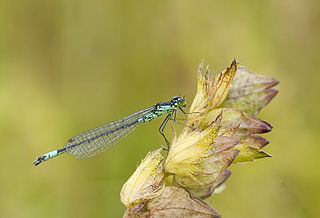
Norfolk damselfly or dark bluet is a species of blue damselfly of the family Coenagrionidae. This species acquired its common name from its discovery in 1903 and presence in a very restricted area of the Norfolk Broads. Records came from Sutton, Stalham, and Hickling Broads.

Arabicnemis is a monotypic genus of damselflies in the family Platycnemididae containing the single species Arabicnemis caerulea. It is known commonly as the powder blue damselfly. It is endemic to the Arabian Peninsula, where it occurs in Oman, the United Arab Emirates, and Yemen.

Azuragrion is a genus of damselfly in family Coenagrionidae. The genus contains the following species:
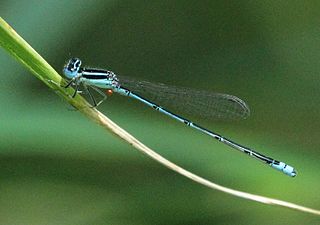
Azuragrion nigridorsum, the black-tailed bluet or sailing bluet, is a species of damselfly in family Coenagrionidae.
Azuragrion vansomereni is a species of damselfly in family Coenagrionidae. It is found in Cameroon, Ivory Coast, Ethiopia, Gambia, Ghana, Nigeria, Senegal, Sudan, Togo, Uganda, and possibly Angola. Its natural habitats are dry savanna, moist savanna, subtropical or tropical dry shrubland, subtropical or tropical moist shrubland, subtropical or tropical dry lowland grassland, freshwater marshes, and intermittent freshwater marshes.

Ceriagrion is a genus of damselfly in the family Coenagrionidae. Species of Ceriagrion are small to medium size, generally brightly coloured damselflies. They are found across the Old World, Africa, Asia and Australia.

Ceriagrion glabrum is a species of damselfly in the family Coenagrionidae. Its common names include common orange, common citril, common pond damsel, common waxtail, orange waxtail and gewone aljander. It is widespread in Africa, where it is found in habitats that are dominated by reeds.
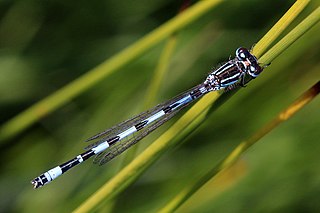
Coenagrion mercuriale, the southern damselfly, is a species of damselfly in the family Coenagrionidae. It is found in Algeria, Austria, Belgium, France, Germany, Italy, Liechtenstein, Luxembourg, Morocco, the Netherlands, Portugal, Romania, Slovakia, Slovenia, Spain, Switzerland, Tunisia, and the United Kingdom. Its natural habitats are rivers and freshwater springs. It is threatened by habitat loss.

Crocothemis sanguinolenta is a species of dragonfly in the family Libellulidae. It is found in Africa south of the Sahara, in the Levant, and in the south of the Arabian Peninsula.

Enallagma recurvatum, the pine barrens bluet, is a species of damselfly in the family Coenagrionidae. It is endemic to the United States. Its natural habitat is freshwater lakes. It is threatened by habitat loss.
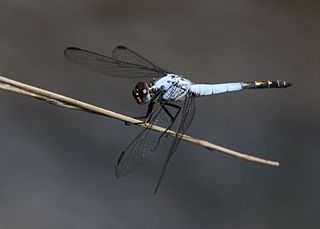
Nesciothemis farinosa (Eastern Blacktail) is a species of dragonfly in the family Libellulidae.

Paragomphus genei is a species of dragonfly in the family Gomphidae.

Paragomphus sinaiticus, the Sinai hooktail, is a species of dragonfly in the family Gomphidae. It is found in Egypt, Niger, Oman, Saudi Arabia, Sudan, United Arab Emirates and Yemen. Its natural habitats are rivers and freshwater springs. It is threatened by habitat loss.
Pseudagrion arabicum is a species of damselfly in the family Coenagrionidae. It is found in Saudi Arabia and Yemen. Its natural habitat is rivers. It is threatened by habitat loss.

Pseudagrion hamoni, the swarthy sprite, is a species of damselfly in the family Coenagrionidae.

Pseudagrion kersteni, powder-striped sprite, Kersten's sprite or the powder-striped sprite, is a species of damselfly in the family Coenagrionidae. It is found in Angola, Benin, Burkina Faso, Cameroon, Central African Republic, Chad, the Republic of the Congo, Ivory Coast, Equatorial Guinea, Ethiopia, Ghana, Guinea, Kenya, Malawi, Mali, Mozambique, Namibia, Nigeria, Somalia, South Africa, Sudan, Tanzania, Togo, Uganda, Zambia, Zimbabwe, and possibly Burundi. Its natural habitat is rivers.
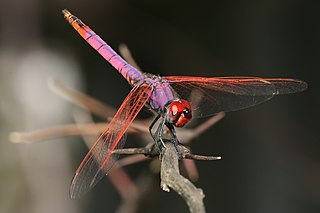
Trithemis is a genus of dragonflies in the family Libellulidae. They are commonly known as dropwings. There are over 40 species, mainly from Africa; two are endemic to Madagascar, and five can be found in Asia. They are found in a wide variety of habitats; some species being adapted to permanent streams in forests, and others being capable of breeding in temporary pools in deserts.

Trithemis furva, the Navy dropwing, is a species of dragonfly in the family Libellulidae. It is found in Angola, Cameroon, Chad, Ivory Coast, Equatorial Guinea, Ethiopia, Guinea, Kenya, Liberia, Madagascar, Malawi, Mozambique, Namibia, Nigeria, Sierra Leone, Somalia, South Africa, Sudan, Tanzania, Uganda, Zambia, Zimbabwe, and possibly Burundi. Its natural habitats are subtropical or tropical moist lowland forests, dry savanna, moist savanna, subtropical or tropical dry shrubland, subtropical or tropical moist shrubland, rivers, freshwater marshes, and intermittent freshwater marshes.

Proischnura rotundipennis, the round-winged bluet is a species of damselfly in the family Coenagrionidae. It is endemic to South Africa, where it is scarce and localised.
Proischnura polychromatica, the mauve bluet, is a small species of damselfly in the family Coenagrionidae. It is endemic to a small area of Cape Province in South Africa. The adult male has a mauve sheen to its dark-coloured body, a bronze-green thorax striped with mauve, and a pale brown abdomen with a bronze-green dorsal stripe. The female is mainly pale brown. The natural habitat of this damselfly is transient pools in stream beds with floating vegetation, especially sedges. Although previously more widespread, it is now known from a single location where it is threatened by the encroachment of cattle and the loss of suitable habitat. For these reasons, the International Union for Conservation of Nature has rated it as "endangered".

















